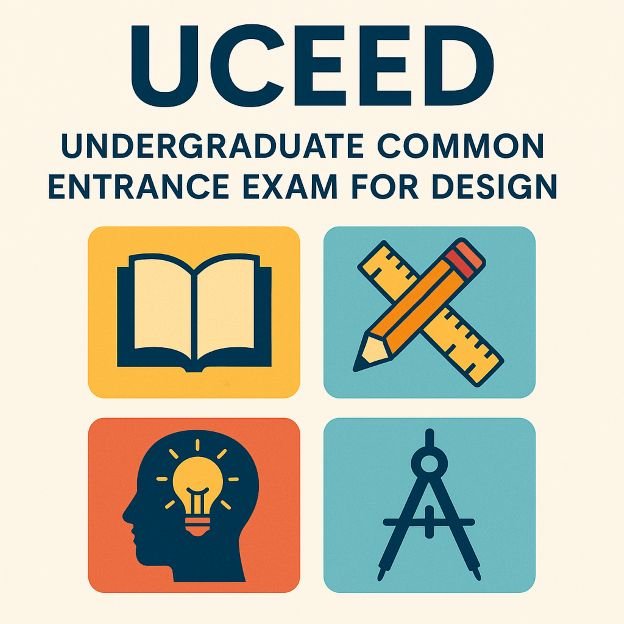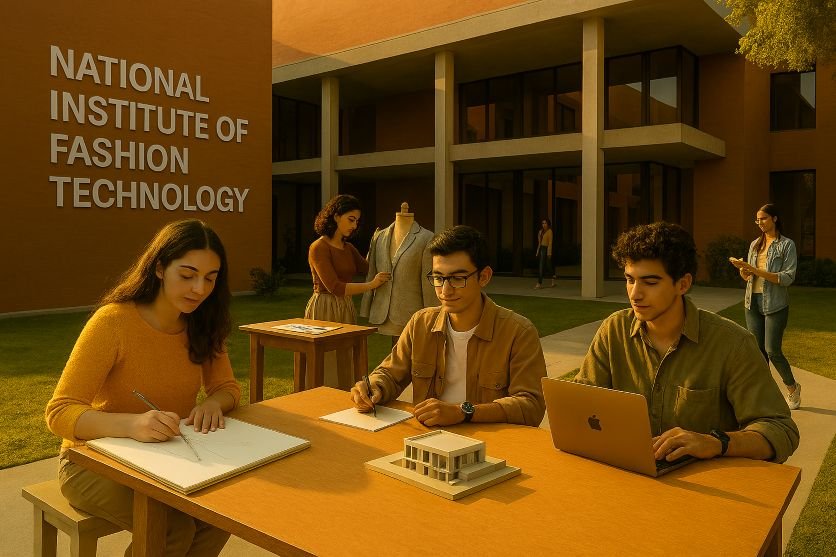UCEED 2026: Everything You Need to Know About the Undergraduate Common Entrance Exam for Design
The field of design is rapidly changing and for those who want to become designers in India it is the Undergraduate Common Entrance Exam for Design (UCEED) can serve as an entry point to some of the most prestigious institutions. If you’re interested in the creative process, innovative thinking and problem-solving the UCEED could be your path to a lucrative job in the field of design. The exam is conducted through the Indian Institute of Technology (IIT) Bombay, this national-level exam tests applicants’ abilities to design at the undergraduate level.
UCEED 2026 Highlights
UCEED 2026 promises to be an important event for students of design with its reputation for being an honest and rigorous exam. The test will be conducted on January 18 2026 from 9:00 AM until 12:00 Noon. This test lasts three hours and is administered in English and split into two sections Part A (computer-based) and Part B (pen-and-paper sketching). The marks total is 300 with zero negative marks in certain sections in order to encourage the use of creativity.
One of the most significant UCEED 2026’s highlights is its emphasis on the holistic assessment. Part A tests the ability to analyze while Part B evaluates drawing skills. The test is accessible to Indian as well as foreign nationals However, the seats are primarily offered to students who are enrolled in B.Des programs at the top IITs. About 20,000 applicants take part annually and compete for 200 seats at participating institutes. Reservations policies are in place, such as 27 percent for OBCNCL, 15 percent of SC, 7.5% for ST and 10 percent for EWS and EWS, as well as additional requirements to PwD candidates.
What’s new for UCEED 2026?
While the complete brochure is scheduled to be released by October 1st 2025, the first indications suggest minor changes to the application process to improve user experience. The test remains available online to take Part A of the exam, which will ensure access to 24 cities across India. The success in UCEED does not just open opportunities towards IITs but also results-sharing institutes such as BITS Design School as well as FLAME University.

UCEED 2026 Important Dates
It is essential to be punctual for any entrance exam as well. UCEED 2026’s Important Dates will assist you in staying in order. Based on announcements from the UCEED official website and the patterns of previous years This is a rough outline of the exam’s timetable:
- Release of Official Notification and Brochure: October 1, 2025
- Start of Online Registration/Application Form: First week of October 2025
- The deadline for registration (without cost of late registration) Last Date for Registration (without late fee): Late October/Early Novemeber 2025
- The Last Date to Register (with the late cost) The deadline for registration is mid-November 2025.
- Admit Card Download 1st week of January 2026.
- Last Date for Admit Card Rectification: Early January 2026
- UCEED 2026 Exam Date: January 18, 2026 (9:00 AM to 12:00 PM)
- Release of Draft Answer Key: Late January 2026
- Last Date for Answer Key Objections: Early February 2026
- Declaratory Results First Week of March 2026
- Scorecard Download: Mid-March 2026
- Start of Counselling/Seat Allotment Application: March 2026
- Round 1 Seat Allotment: April 2026
- Subsequent Rounds: April-May 2026
These dates are not final and are subject to changes. Always visit for confirmations on the UCEED’s official UCEED site for any confirmations. Missing deadlines can disqualify you, so set reminders. For candidates from outside the country, remember that the test is only located in India So plan your travel according to the exam.
UCEED 2026 Eligibility Criteria
- Alter Limit Candidates from OPEN/EWS/OBC/NCL category must have been born after or on October 1st 2000. For SC/ST/PwD candidates, it’s from or after October 1 1995.
- Academic Qualification The requirement is that you have completed your the class 12 (or equivalent) in 2025 or in 2026. All streams are considered eligible, including Science or Commerce, as long as you’ve passed all subjects.
- Limit of Attempts Maximum of two attempts over a period of time. UCEED 2026 counted as a single attempt.
- nationality: Indian nationals and OCI/PIO card holders are able to reserve seats. Foreign nationals are eligible for supernumerary seats.
A minimum percentage of Class 12 must be achieved to sit for the test, however some institutes might have cutoffs to be met to be considered for admission. If you’re from a school other than CBSE/ICSE make sure to show that you meet the requirements for equivalence. PwD candidates can avail concessions, such as Scribe facilities. Check your eligibility before you start so that you can concentrate on your preparation with no stress.
UCEED Application Form
The UCEED Application Formula will be the initial step towards your design ambitions. The application process is completely online and user-friendly
- Visit the official website: www.uceed.iitb.ac.in.
- Sign up using an email address that is valid and a mobile number.
- Enter personal information, education qualification, then upload the documents (photo signature, the signature of a person, Class 10/12 certificates and proofs of category If appropriate).
- Pick the city of your choice for the exam (up to three cities).).
- The application fees: approximately $3500 for males with OPEN/OBC/EWS. $1,750 for females/SC/ST/PwD. Late fees are Rs500.
- Send and Download the acknowledgement.
The application form will be open starting in early October 2025. Common errors include incorrect photo size (JPEG 4,40 KB) or mismatched information. Double-check everything. If you’re applying for reservation, make sure you upload the appropriate certificates. Once the application is submitted, corrections are only allowed, so be exact.
UCEED Exam Pattern
- Mode: Part A (Online, Computer-Based Test), Part B (Offline, Sketching).
- Duration 3 hours total (Part A 2 hours Part B one hour).
- Total Marks: 300 (Part A: 240, Part B: 60).
- Sections in Part A :
- The Numerical Answer Type (NAT) 18 questions, each with 4 marks (no negative marks).
- Multiple Select Questions (MSQ) 18 questions, with a partial marking (no negatives for incorrect, -0.19 for an error).
- Multiple Choice Questions (MCQ): 32 questions, each with 3 marks (-0.71 for incorrect).
- Part B One sketching issue assessed on proportion, perspective and originality.
The test is designed to test a range of abilities with no calculators permitted. Part B can only be assessed when you are able to pass Part A. Make time management a habit, since switching between paper and screen can be a challenge.
UCEED 2026 Syllabus
Part A Topics:
- Spatial and Visual Ability The ability to visualize and spatialize patterns, pictorial transformations 2D/3D manipulation.
- Design Sensitivity and Observation: Design flaws, hidden figures and aesthetics.
- Social and environmental awareness Climate, culture design and art history.
- Logical and Analytical Reasoning: Problems, data interpretation and arguments.
- Language and Creativity: Reading comprehension grammar and metaphors.
- The Design Thinking as well as Problem Solving Design Thinking: Solutions based on user-centricity Innovation.
Part B Drawing – Ability to draw people, products or even scenes using excellent quality lines, composition and shading.
There are no changes expected in 2026. Concentrate on practical applications, such as analyzing everyday objects. Materials like old studies or books that cover visual reasoning can be extremely useful.
UCEED 2026 Admit Card
It is the admit card for the UCEED exam in 2026 is your ticket into the examination hall. Download it on the official website in early January of 2026, using your login ID and password. It contains your name, picture exam center, timing and directions.
Steps to Download:
- Log into uceed.iitb.ac.in.
- Click on ‘Admit Card’.
- Verify the information and print multiple copies.
Report discrepancies before January 2026. On the day of the test, be sure to carry an ID that is valid (Aadhaar/Passport) in addition to the admit card.
UCEED 2026 Result
To Check:
- Log in to the portal, then visit the portal. in.
- Check your ranking, mark and the status of your qualification.
- Get the Scorecard (valid for a year).
UCEED 2026 Counselling Process
- Log in on the internet (March 2026) Pay Rs2,000 for registration (non-refundable).
- Choose from the institutes/programs you would like to apply for.
- Uploading documents (Class 12 marksheet and categorical certificate).
- Seat allocation for 3 rounds (April-May 2026).
- Accept the seat, pay the charges (Rs60,000 in the case of IITs) and then make a report to the institute.
It’s a joint effort between IITs. Upgrades possible in later rounds. Make a withdrawal prior to the final round to claim a refund. Stay updated via email/SMS.
UCEED Top Colleges
- IIT Bombay (IDC): Pioneer in design education, 30 seats.
- IIT Delhi: Focus on product design 20 seats.
- IIT Guwahati: Emphasis on interaction design 56 seats.
- IIT Hyderabad: Innovative curriculum with 26 seats.
- IIITDM Jabalpur: Industrial design focus, 66 seats.
Colleges that share their results comprise:
- BITS Design School, Mumbai.
- FLAME University, Pune.
- World University of Design, Sonipat.
- UPES Dehradun.
These provide B.Des in different specializations such as communication, product, or animation. You can choose based on your where you live, the cost (Rs2-4 lakhs per year) and locations (average of Rs10-15 LPA).
Preparation Tips for UCEED 2026
To be a top performer to be successful UCEED in the year 2026 Start with the basics early. Create a study plan and dedicate 2-3 hours per day to drawing and analyzing. Utilize books such as “UCEED Design Environment and Social Awareness” and online mocks. Participate in coaching when needed Institutes such as Rathore Design offer specialized courses. Examine past papers to find patterns.
UCEED 2026 FAQ’s
- What exactly is UCEED?
A: UCEED is the Common Entrance Exam in Undergraduate Studies to design for B.Des admissions to IITs and other institutions. - The date for when start the UCEED 2026 application begin?
A: Expected in the first week of October 2025. - Does there exist negative markings within UCEED?
A: Yes, in MCQ section of Part A (-0.71) Partially part of MSQ (-0.19) None in Part B or NAT. - Do I have to attempt UCEED more than two times?
A: No, maximum two consecutive attempts. - How can I make sketches for the Part B?
A: Practice daily with pencils, focusing on shading and perspective. Refer to sample questions. - What if I fail the date of my exam?
A: No re-exam; you’ll need to wait until the next year’s exam. - Are foreigners qualified?
A: Yes, but seats are not available under the supernumerary categories. - What is the method of calculating ranks?
A: Based on total marks. Tie-breakers are based on Part B Then section-wise scores.


